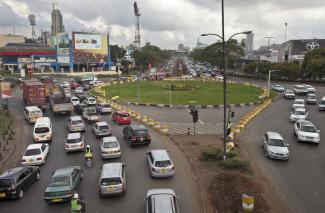Technology
Generating broad-based wealth

Robots are designed to replace human workers, and they are becoming ever more effective. Is advancing information technology making the established development pattern obsolete, according to which a poor country starts to industrialise on the basis of cheap labour and then gradually catches up with the world market in other fields?
I would argue that some robots are designed to replace human labour, others to augment it or to offer entirely new services. Projections on the impact of automation in developing countries range from a loss of employment up to 55 % in Uzbekistan or 85 % in Ethiopia. In the US, for example, a number of companies are currently investing heavily in robotics with the aim to bring back significant parts of the sewing industry. There are, however, two ways to look at it. The first is to bemoan that a development trajectory that we have become used to is becoming unviable. The other is to look for better development trajectories. Low-paid labour is evidently a comparative advantage of developing countries and used to hold the promise of economic productivity gains and employing low-skilled labour. This is likely to change. In addition to striving for environmental sustainability, reducing inequalities and ensuring fair wages, developing countries will have to work on trajectories that are not build on the historic advantage of low-paid labour. A herculean task. To tackle it, most policy recommendations focus on capabilities and connectedness, so education and trade based on comparative niche advantages.
Can digital technology be useful for that purpose?
Yes, there are opportunities to redefine development trajectories through digital leapfrogging, but it will only be possible if it goes along with many other investments. Basic infrastructure, human capital, business environments, redistribution and social safety nets must all improve. To compete with currently available IT applications, people increasingly require a tertiary education, which is still rare throughout the developing world. There is thus a need to act at several levels. We need public discourse on redistribution and how a society defines the creation of value.
In any case, we must prepare for human labour being made redundant?
We are facing serious problems, no doubt. Policymakers are well advised to ponder what may happen in the future. Historical experience inspires some slight optimism: since the start of the Industrial Revolution in Britain in the 18th century, people have kept worrying about machines replacing workers. Indeed, technological progress can affect lower and middle classes negatively. On the other hand, new technological options have historically created more jobs than they made obsolete. The nature of work is changing – in parts fundamentally. We need to understand whether the negative impacts on labour are of a transitory nature and can be dealt with through re-skilling, or whether there are some mechanisms at play that should make us worry about excessive automation. Projections show widening disparities and decreasing opportunities for low-skilled labour. In view of these trends, governments and development agencies have a role to play in shaping narratives. It makes sense to collectively rethink what kind of work should be automated and how different kinds of labour are valued and remunerated. It is necessary to appreciate manual labour and reward it fairly. Innovative policies are needed, and concepts such as a universal basic income will become increasingly important. After all, “Leave no one behind” is a guiding principle of the Sustainable Development Goals.
Does digital technology offer opportunities to people with higher education in developing countries?
Yes, we see creative work being decentralised internationally. Tech hubs have emerged in places like Bangalore, Nairobi and elsewhere. Opportunities for digital workers are opening up across the world. Moreover, new technologies offer opportunities to protect the environment. Satellite images and machine learning can contribute to better understand the implications of current policies on biodiversity, for example, and crowdfunding can make investments in renewable power generation affordable, to name only a few examples.
Let’s discuss the upsides and downsides of important technological trends. If unemployment is the risk that is posed by automation, what advantages can developing countries expect?
First of all, let me highlight persistent barriers to technology access. Today, over a billion people still lack electricity, and three billion lack access to clean and safe cooking technology. Illiteracy is still a serious problem in many places. Less than half of the world population uses the internet. That said, the potential benefits of emerging technologies are considerable. Bear in mind that the cell phone has been and continues to be a game changer for financial inclusion. Drone delivery of pharmaceuticals and vaccines to remote rural areas is a more recent example of technology-driven progress. Drones make it easier to provide hard-to-reach communities with health care. Another example is self-driving cars. They hold the promise to massively reduce congestion and pollution in megacities like New Delhi, Nairobi or Lima with potentially immense positive effects on economic productivity too.
Apart from automation, there are two other decisive trends as far as I can tell: big data and artificial intelligence. Am I missing something important?
Well, there are many important trends, and they tend to be interrelated. I think policymakers should focus on the trends you mentioned plus blockchain and bioethics. Humans are generally bad in predicting the future, especially if scenarios look threatening. It is important to plan for unexpected scenarios.
Let’s take a look at big data. Do you have examples of tangible advantages?
Yes, I do, but let me state first that big data alone often does not suffice. The data generated by consumers who use mobile phones, social media, online search engines usually needs to be backed up with other data such as household surveys, national censuses et cetera. Otherwise, we may get distorted pictures. For example, we know that more men than women use digital devices, so the data trails tell us more about men’s preferences than women’s. We can address the sexist gender gap, but to do so, big data usually needs to be complemented with the thick data of statistics generated by conventional means and additional qualitative research to gain insights about those who are most marginalised. Done properly, big data analysis will provide relevant insights into the lives of people, including at the base of the pyramid. In recent years, UNDP has been investing in the matter, often in collaboration with UN Global Pulse and national governments. The results are interesting.
- In Sudan, for example, UNDP is working with partners including German academic institutions on real-time insights on poverty. Official poverty statistics are being complemented by big data from night-time lights, mobile phones and electricity consumption. Policymakers thus get a more complete picture of where poor people live. The approach has made data collection much more efficient.
- In Indonesia, big data is helping to improve flood preparedness as well as responses to flooding. Twitter is very popular in Indonesia, so the analysis of Twitter conversations is useful, generating insights and enabling various partners from civil society and the government to act. This method helps to verify reports and reach out to flood victims in real time, for example.
And what are the risks of big data?
There are serious issues of privacy. If you assess a person’s browsing preferences, for example, you can gain multiple insights, concerning the person’s sexual orientation, political views or health status. Such information can be misused. A significant part of the data that consumers generate is in the hand of a few powerful private-sector companies, including online retailers, telecom companies, social media platforms or search engines. To the extent that governments get access to such data, they may use it to stifle opposition and block civil disobedience. Such negative impacts will haunt us if we do not establish data protocols and accountability systems. More generally speaking, we need to invest in supporting individuals to develop an emancipatory and yet protective relationship with their own data.
Let’s consider artificial intelligence (AI). What potential do you see?
There is scope for important efficiency gains. AI can widen policymakers’ horizons for example. Algorithmic scrutiny of big data can literally open their eyes on issues such as the effects of current paces of deforestation. In Central America, for example, AI can show what impacts current policies for pineapple production have on biodiversity. All too often, the people who take decisions are not aware of implications for the larger system. Another area in which artificial intelligence may prove useful is criminal justice. Judicial systems are over-burdened in many countries and people’s trust in them is decreasing. Algorithms can contribute to managing judicial affairs better and speed up procedures.
But couldn’t AI just as likely compound existing problems? To my knowledge, AI is generally based on big samples of human action, with computer programmes being designed to replicate the decisions made by most of the human beings who are considered to be relevant in a specific context. If a country’s legal system is biased against a certain minority, the decisions of relevant people will reflect that bias, so won’t AI reinforce it as well?
Yes, that has already happened. In some countries, algorithmic decisions were indeed biased against minorities – due to biases in the data that was provided to train the algorithm. But it would also be possible to design the programmes in ways to avoid biases. This is a prime example of technological progress offering opportunities and posing risks at the same time. It is possible to improve – rather than merely replicate – performance. For this to happen, we need transparent scrutiny for data sets that are provided to algorithms and diversity among those who write the programmes. That would happen if more young women and more members of minorities graduated in STEM – science, technology, engineering and mathematics. Governments should promote them. At the same time, private-sector companies must ensure diversity among their staff. We need multi-sectoral fora that discuss AI progress, principles and accountability systems.
My suspicion is that artificial intelligence isn’t actually very intelligent. If it is basically designed to replicate the average behaviour of relevant human beings, performance will by definition be mediocre. That is preferable to bad performance, of course, but worse than excellent performance. We are increasingly being admonished to “think outside the box”, but can AI do that at all?
Well, the standard uses of AI so far are not thinking outside the box, but technology is advancing. We are now seeing creative AI, with programmes writing poems or composing music. We are discussing the emergence of Artificial Super Intelligence – AI that would be able to make creative choices better than humans do, generally surpass human cognitive capabilities and be able to undertake reasoning. That is the kind of AI some technology enthusiasts like Tesla founder Elon Musk warn us about. One of my favourite quotes is from the Italian politician and philosopher Antonio Gramsci. He said: “I am a pessimist by intellect, and an optimist by will.” To guide technological future on a trajectory that benefits human fulfilment and freedom, this seems to be a good paradigm.
Benjamin Kumpf leads the UNDP Innovation Facility in New York.
https://twitter.com/bkumpf
Link
In its recently published annual report, the UNDP Innovation Facility shares case studies from over 25 countries:
http://www.undp.org/innovationreport













